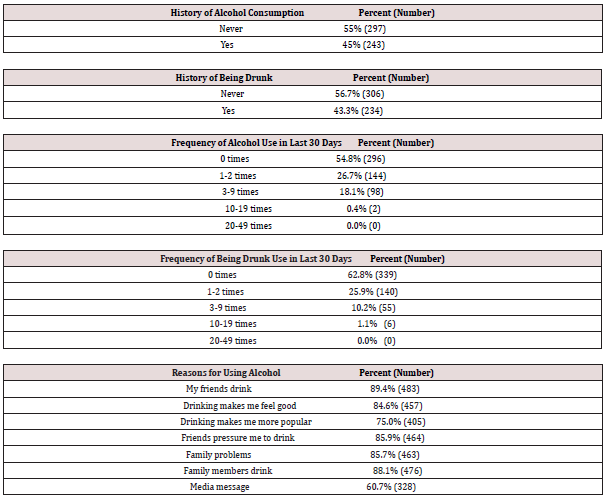
Lupine Publishers Group
Lupine Publishers
Menu
ISSN: 2637-6695
Case Report(ISSN: 2637-6695) 
A Case Report of Alcohol Consumption Among Native American Youth Research Brief Volume 3 - Issue 4
John Lowe RN1*, Melessa Kelley2, Cynthia Greywolf3 and Rose Wimbish-Tompkins4
- 1Joseph Blades Centennial Memorial Professor, University of Texas at Austin School of Nursing, USA
- 2Assistant Professor, University of Texas at Austin School of Nursing, USA
- 3Provost’s Early Career Cohort Fellowship Program, University of Texas at Austin School of Nursing, USA
- 4T32 Postdoctoral Fellow University of Texas at Austin, Steve Hicks School of Social Work, USA
Received: September 13, 2022; Published: September 28, 2022
Corresponding author: John Lowe RN, Joseph Blades Centennial Memorial Professor, University of Texas at Austin School of Nursing, USA
DOI: 10.32474/LOJNHC.2022.03.000167
Introduction
Native American youth experience higher alcohol use rates compared to the national average, initiate use at a younger age, and lack access to culturally appropriate prevention efforts that incorporate Native American cultural values and beliefs [1]. One in six Native American adolescents ages 12 to 17 engage in underage drinking, the highest rate of alcohol use of all racial/ethnic groups [2]. Despite a general decline in alcohol use rates over the last decade among youth in the mainstream population, alcohol use among Native American youth remains very concerning Alcohol is the most frequently used drug of choice among Native American youth. The experience with alcohol during the Native American’s teenage years often escalates during an important developmental period yet stressful transitional time period. In a recent study, nearly 9.2% of Native Americans aged 12 and older reported current heavy alcohol use, the highest rate of any ethnic group. Forty-four percent of Native American youth, ages 12-17 reported using alcohol in the last 30 days, and approximately 27.6 % reported binge drinking within the last 30 days compared to 24.7% of Non-Hispanic Whites [3]. Studies reporting alcohol use among Native American youth ages 10-12 are almost nonexistent. The purpose of the study was to collect baseline data regarding alcohol use among rural nonreservation based Native American youth, ages 10-12.
Methods
This study used a cross-sectional design to survey a convenience sample of 540 Native American youth, ages 10-12. The Native American Alcohol Measure for Youth (NAAMY) includes 18 items and was used to collect the data. Due to the lack of assessments specific to alcohol use among Native American youth, the research team developed the NAAMY as a new instrument. The psychometric evaluation of the NAAMY is being prepared to be reported in another article.
Participant Responses
Participating Native American youth were recruited and consented to complete the NAAMY baseline measure as part of a larger substance use prevention study being implemented in public schools. The average age of the participants was age 11 which included 280 females and 260 males’ Native American youth from three Native American rural non-reservation tribal communities located in North Carolina, Minnesota, and Oklahoma. The data were aggregated, and the youth were not asked about tribal affiliations. Due to IRB restrictions tribes located in the target areas cannot be identified (Table 1) reports the participant responses regarding alcohol consumption.
Discussion and Summary
The participant responses suggest that Native American youth are initiating alcohol consumption at early ages in life. Early initiation of alcohol use has been linked to behavioral issues particularly among Native American youth. The ages of 10-12 is a particularly vulnerable time for essential growth patterns involving psychological, social, emotional, physical development, and behavior. Evidence suggests that the transition from youth into adulthood is a developmental stage where learned behaviors, can increase or decrease one’s risk for alcohol use and risky health behaviors [4]. This is also a very crucial time for the development of emotional and peer support. As reflected in the participant responses, when youth lack appropriate emotional, and peer support the potential for alcohol use increases. Prevention and intervention efforts to reduce alcohol use must be addressed during this critical transitional developmental stage among Native American youth.
Acknowledgement:
This research was supported in part by funding from grant NIDA/NIAAA R01DA035143.
References
- Kelley A, Witzel M, Atupaito B (2019) Preventing Substance Use in American Indian Youth: The Case for Social Support and Community Connections. Substance use & misuse 54(5): 787-795.
- Stanley LR, Swaim R C (2018) Latent Classes of Substance Use Among American Indian and White Students Living on or Near Reservations, 2009-2013. Public health reports (Washington, D.C 1974, 133(4): 432-441.
- Park-Lee E, Lipari R N, Bose J, Hughes A, Greenway K, et al. (2018) Substance use and mental health issues among U.S.-born American Indians or Alaska Natives residing on and off tribal lands. CBHSQ Data Review.
- Spillane NS, Nalven T, Goldstein SC, Schick MR, Kirk-Provencher KT, et al. (2022) Assaultive trauma, alcohol use, and alcohol-related consequences among American Indian adolescents. Alcoholism, clinical and experimental research 46(5): 815-824.
Editorial Manager:
Email:

Top Editors
-

Mark E Smith
Bio chemistry
University of Texas Medical Branch, USA -

Lawrence A Presley
Department of Criminal Justice
Liberty University, USA -

Thomas W Miller
Department of Psychiatry
University of Kentucky, USA -

Gjumrakch Aliev
Department of Medicine
Gally International Biomedical Research & Consulting LLC, USA -

Christopher Bryant
Department of Urbanisation and Agricultural
Montreal university, USA -

Robert William Frare
Oral & Maxillofacial Pathology
New York University, USA -

Rudolph Modesto Navari
Gastroenterology and Hepatology
University of Alabama, UK -

Andrew Hague
Department of Medicine
Universities of Bradford, UK -

George Gregory Buttigieg
Maltese College of Obstetrics and Gynaecology, Europe -

Chen-Hsiung Yeh
Oncology
Circulogene Theranostics, England -
.png)
Emilio Bucio-Carrillo
Radiation Chemistry
National University of Mexico, USA -
.jpg)
Casey J Grenier
Analytical Chemistry
Wentworth Institute of Technology, USA -
Hany Atalah
Minimally Invasive Surgery
Mercer University school of Medicine, USA -

Abu-Hussein Muhamad
Pediatric Dentistry
University of Athens , Greece

The annual scholar awards from Lupine Publishers honor a selected number Read More...





